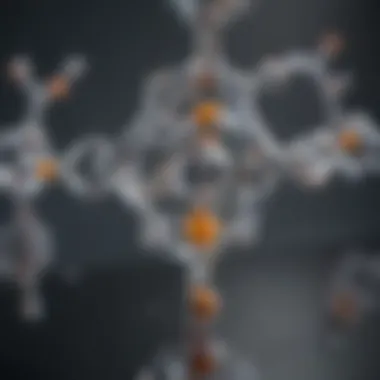In-Depth Analysis of the Ehrlich Reagent: Uses and Impact


Intro
The exploration of the Ehrlich reagent is akin to peeling an onion—each layer unveils critical insights into its role within the biochemical sphere. Originating from a rich historical context, this reagent has evolved into a cornerstone for various applications, especially in clinical diagnostics and environmental assessments. Its unique chemical structure not only allows for intriguing methodologies but also raises questions about its implications for future scientific endeavors.
In this piece, we’re not just skimming the surface. We’re diving deep into the nuances of what the Ehrlich reagent offers, examining its past, present, and potential future. We aim to showcase the relevance of this reagent in advancing laboratory practices, as well as how it intertwines with broader scientific pursuits.
The relevance of understanding the Ehrlich reagent goes beyond academic exploration; it shapes the way we approach diagnostics and environmental science today. Through our discussion, we will highlight its unique chemical attributes, delve into methodologies of application, and even touch on alternatives that may rise to prominence in the near future.
Prelude to the Ehrlich Reagent
The Ehrlich reagent holds a pivotal position in chemical analysis, especially within the realms of biochemistry and medical diagnostics. Understanding its significance reveals the intricate connections between laboratory science and everyday medical practices. The reagent itself, primarily known for its sensitivity to certain compounds, serves as a key indicator for various biochemical substances, particularly applications surrounding the identification of substances like indoles and alkaloids. Its relevance stretches from clinical diagnostics to environmental monitoring, thereby providing invaluable insights.
Definition and Composition
To grasp the full impact of the Ehrlich reagent, one must first understand what it is. The Ehrlich reagent is predominantly a solution of p-dimethylaminobenzaldehyde. It reacts with amino acids and various indole derivatives to form distinct colored compounds, making it a reliable tool for qualitative analysis. This reagent's simplicity in composition doesn't belittle its functionality; rather, its effectiveness lies in this very straightforwardness. The reaction generally yields a rosy to purple coloration, which further assists in diagnostics related to drugs and metabolic disorders. Such characteristics make the Ehrlich reagent an indispensable asset in laboratories where precision and reliability are paramount.
Historical Development
The journey of the Ehrlich reagent traces back to the late 19th century, attributed largely to the efforts of the eminent chemist Paul Ehrlich. Initially focused on dye chemistry, Ehrlich’s curiosity led to the exploration of how certain compounds reacted when mixed with biological specimens. His work paved the way for utilizing these chemical interactions in medical diagnostics, revolutionizing how we approach biochemical analysis. Over the years, its applications expanded, encompassing areas far beyond its original scope.
By the mid-20th century, the prominence of the Ehrlich reagent surged in clinical settings, particularly in laboratories aimed at drug detection. As a result, its historical significance not only illustrates its origin but also highlights its ongoing relevance in modern science. Today, the Ehrlich reagent is used with a keen understanding of its historical context alongside ongoing developments in its application, thus maintaining its status as a cornerstone in the field.
"The past is not dead; it is not even past." — William Faulkner
Chemical Structure and Properties
The Chemical Structure and Properties of the Ehrlich reagent form the backbone of its utilization in various analytical scenarios. Understanding these aspects is crucial as they govern how the reagent interacts with other substances, its stability under different conditions, and its effectiveness in producing measurable results. Each of these factors contributes to the reliability and accuracy of tests conducted using the Ehrlich reagent, which many fields—ranging from clinical diagnostics to environmental monitoring—heavily rely on.
Molecular Structure
The molecular structure of the Ehrlich reagent is characterized by its complex organic composition, typically identified as a derivative of umbelliferone. Structurally, it features a fused ring system with hydroxyl groups attached, making it conducive for interactions with various amines and amino acids. The presence of these functional groups is what allows the reagent to exhibit significant reactivity, especially when it forms colored complexes that signal the presence of specific analytes. Understanding its molecular framework assists researchers in predicting its behavior during testing, which is vital for accurate analysis.
Additionally, the conformation of the molecule, involving spatial arrangement of atoms, can affect its reactivity. Subtle changes in the environment, such as pH or temperature, might impact this conformation, leading to variance in results.
Physical Characteristics
The physical characteristics of the Ehrlich reagent are equally significant. In its common form, it appears as a colorless or slightly yellow liquid. This aspect is critical since any impurities can skew test results. It also has a moderate volatility, which makes it easy to dispense and manipulate without requiring specialized equipment. Furthermore, the reagent has a distinct solubility in water and organic solvents, contributing to its versatility in various laboratory settings.
Understanding these physical properties is essential. If a researcher knows that the reagent has limited stability in certain conditions, they can optimize their protocols to ensure integrity of their analyses. Being aware of how temperature fluctuations might cause precipitation or evaporation also informs good laboratory practices.
Chemical Behavior
When discussing the Chemical Behavior of the Ehrlich reagent, one must consider its interaction with amino compounds. It notably reacts with compounds such as tryptophan, leading to the formation of a vibrant color change, often seen as a deep pink or violet hue. This reaction illustrates not just the reagent's utility in biochemical testing, but also its selectivity toward specific molecules, an aspect that allows for greater precision in diagnostics.
However, it's important to recognize that the reagent is not without its challenges. Its behavior can be influenced by the presence of other substances, potentially leading to false positives or negatives. Therefore, understanding the breadth of reactive potential is paramount in maintaining the chemical integrity of results. For instance, secondary amines or similar structures may also elicit a response, which complicates interpretation.


"A sharp understanding of the reagent's behavior in varying conditions can dramatically enhance the reliability of biochemical tests."
In summary, comprehending the Chemical Structure and Properties of the Ehrlich reagent is not merely an academic exercise but a practical necessity in the lab. This knowledge forms a conceptual framework for its numerous applications and implications, guiding researchers toward informed observations and experimentations.
Applications in Biochemical Analysis
The Ehrlich reagent plays a crucial role in biochemical analysis, serving as a reliable tool for detecting specific compounds in various contexts. This section elaborates on its value by examining its applications in the domains of clinical diagnostics, toxicology reports, and environmental monitoring. The broad applicability of the Ehrlich reagent speaks to its versatility in scientific inquiry, helping to illuminate complex biochemical interactions.
Clinical Diagnostics
In the field of clinical diagnostics, the Ehrlich reagent is primarily utilized for identifying the presence of certain amino acids and metabolites in biological fluids. One of the most notable applications is in the detection of porphyrins, which are critical for understanding disorders related to heme synthesis. When samples obtained from patients are treated with the Ehrlich reagent, a vibrant color change can indicate the presence of specific compounds like uroporphyrin or coproporphyrin. This quick, colorimetric response not only facilitates timely diagnoses but also minimizes the need for lengthy and complex procedures.
In hospitals and laboratories, the reagent's ability to deliver rapid results can be a game changer in urgent situations. For instance, a physician seeking to determine the cause of abdominal pain might suspect a porphyria-related issue. By employing the Ehrlich reagent in conjunction with other tests, clinicians can quickly rule in or out potential diagnoses, enabling them to formulate appropriate treatment plans without unnecessary delays.
Toxicology Reports
When it comes to toxicology reports, the Ehrlich reagent serves as an essential tool in detecting illicit substances, particularly when one examines the metabolic byproducts of drugs. After obtaining biological samples, such as urine, the reagent can be employed to identify tryptamines and related compounds, allowing for swift toxicological assessment. The efficiency of this reagent in spotting substances like 3,4-methylenedioxymethamphetamine (MDMA) is pivotal for public health and safety.
Further, professionals in forensic science often lean on the Ehrlich reagent for substance identification, making it an integral part of toxicological analysis. In the case of a suspected overdose, for example, law enforcement agencies may expedite the screening process by utilizing this reagent. By quickly identifying the presence of specific drugs, they can take prompt action, whether it's providing medical assistance or gathering evidence for legal proceedings.
The speed and reliability of the Ehrlich reagent make it an invaluable asset in the world of forensic toxicology, often serving as the first line of defense in drug detection.
Environmental Monitoring
The role of the Ehrlich reagent extends to environmental monitoring, where it is used to detect amino compounds in various ecological settings. In water quality assessments, for instance, the reagent can help identify pollutants or biological indicators of ecosystem health. When water samples are treated with the Ehrlich reagent, a reaction may point towards the presence of harmful substances, facilitating measures to safeguard public health and preserve the environment.
Moreover, regulatory agencies utilize test results derived from the Ehrlich reagent to establish compliance with environmental standards. By monitoring effluents released into rivers and lakes, scientists can determine whether industrial operations adhere to safety protocols and environmental regulations. The reagent's straightforward procedure aids in rapid assessments, thus making it easier to tackle pollution proactively.
In summary, the Ehrlich reagent significantly contributes to various fields of biochemical analysis. Its applications in clinical diagnostics, toxicology reports, and environmental monitoring highlight its versatility and reliability. As science progresses, the continued exploration of the Ehrlich reagent's capabilities may yield even broader implications, presenting opportunities for innovation across diverse sectors.
Methodologies Utilizing the Ehrlich Reagent
The methodologies that incorporate the Ehrlich reagent are crucial for understanding how we can accurately measure and analyze various biological compounds. Over time, these methods have evolved, adapting to the ever-growing demands of research and diagnostics in clinical and environmental settings. The significance of these methodologies lies not just in their utility, but also in their ability to deliver reliable results under varying conditions. Researchers, clinicians, and students alike benefit from a robust grasp of these techniques as they pave the way for advancements in medical diagnostics and environmental safety assessments.
Procedure for Testing
Conducting tests with the Ehrlich reagent can seem daunting at first glance, yet it is quite a streamlined process once one understands the steps involved. Here’s a breakdown of the general procedure:
- Sample Preparation: Begin by collecting the sample that needs testing. Depending on the field of application, this could range from biological fluids like urine to environmental water samples.
- Reagent Addition: Introduce the Ehrlich reagent to the prepared sample. The typical ratio is about equal volumes of sample and reagent, but adjustments can depend on specifics of the study.
- Incubation: Allow the mixture to incubate for a duration that can vary from several minutes to a few hours. Optimal incubation time is key; too short or too long can lead to misleading results.
- Observation: Following incubation, observe the color change closely. A deep pink to red hue indicates a positive reaction. This visual cue is essential, as it signals the presence of indole or related compounds.
- Documentation: Record all observations meticulously for further analysis.
This stepwise approach ensures that results are not only replicable but also that they adhere to established standards of biochemical testing. It's like making a perfectly brewed cup of tea; whether too weak or too strong, the balance must be just right.
Interpretation of Results
Interpreting results from tests utilizing the Ehrlich reagent requires a keen understanding of both the chemical interactions at play and the context in which the test was conducted. The color intensity and its shade provide immediate visual feedback on the presence of the target compound.
- Positive Reaction: A strong red color signifies high indole concentration, suggesting a significant presence of compounds derived from protein metabolism.
- Weak or Negative Reaction: A faint pink or no color change might indicate minimal presence or absence of indole. However, it’s wise to consider factors such as sample quality and reagent validity.


"Understanding how to draw conclusions from colorimetric tests is as important as the accuracy of the tests themselves."
The results should not only be analyzed in isolation but should also incorporate findings from other tests or background research. This multifaceted view mitigates the risks of overlooking relevant factors that could affect the interpretation.
In summary, mastering the methodologies utilizing the Ehrlich reagent enhances analytical capabilities, ensuring that findings are both accurate and applicable in real-world contexts. As we progress, the ongoing refinement of these methodologies will likely lead to even more reliable results in diverse fields of study.
Limitations and Challenges
The examination of the Ehrlich reagent is not without its pitfalls. Understanding these limitations and challenges is essential for ensuring accurate applications in biochemical analyses, diagnostics, and environmental monitoring. This section dives into notable issues, ranging from sensitivity problems to specificity complications, which can impact the effectiveness and reliability of this chemical tool.
Sensitivity Issues
Sensitivity is often a double-edged sword in analytical chemistry. The Ehrlich reagent, while effective, has its own sensitivity issues that scientists need to be aware of. If the concentration of the target compound is too low, the reagent may fail to produce a visible response. Conversely, in cases where concentrations are excessively high, it may lead to overwhelming signals, masking the actual results and potentially leading to inaccurate interpretations.
Some studies have indicated that environmental samples may contain various interfering substances that can complicate readings. This interference can distort the sensitivity of the Ehrlich reagent, creating a veil over the true levels of targeted analytes. For instance, when analyzing urine samples for certain metabolites, competing ions or molecules might hinder the expected interactions. The applicability of Ehrlich’s reagent here starts to become muddled, suggesting that its use may not always yield definitive answers.
"In the realm of analytical methods, reliability often hinges on the balance between sensitivity and specificity. In the case of the Ehrlich reagent, sensitivity issues present a maze that requires careful navigation."
Specificity and Cross-Reactivity
Specificity is a cornerstone of any reliable analytical method, and the Ehrlich reagent stands at a crossroads here as well. The substance has been known to react with a variety of compounds beyond the intended targets. This can result in cross-reactivity, where the reagent indicates a positive result for substances that are not actually the target of interest.
For example, numerous amines can give rise to false positives when using the Ehrlich reagent. Such cross-reactivity can mislead the diagnostic process in clinical settings. This kind of complication is particularly concerning when the results are used to make health-related decisions.
Moreover, environmental samples often carry a menagerie of compounds that can interact unpredictably. Situations where one might expect to see a clear path could instead reveal a tangle of results, making it hard for researchers to draw conclusive patterns. This ambiguity highlights the crucial necessity for follow-up tests or the utilization of complementary methods to validate results obtained from the Ehrlich reagent.
In the intricate dance of analytics, a scientist must remain vigilant about the potential for misleading readings due to these specificity issues. Improved methods or modified versions of the reagent may emerge as plausible solutions to enhance specificity and reduce the incidence of cross-reactivity in future applications.
Emerging Alternatives to the Ehrlich Reagent
As science marches forward, it's crucial to keep an eye out for new advancements that can replace or improve established methods. The Ehrlich reagent has proven indispensable in various applications, primarily in biomedical contexts, but the field of analytical chemistry is ever-evolving. This section seeks to cover the significance of emerging alternatives, threading through their specific elements, advantages, and implications.
Novel Chemical Reagents
In the quest for more reliable and efficient detection methods, several novel chemical reagents have made their way into the spotlight. These alternatives not only aim to match the performance of the Ehrlich reagent, but they often come equipped with enhanced features that address its limitations.
Some noteworthy examples include:
- Phenolsulfonic Acid: Known for its sensitivity, this reagent offers a sharp contrast to the conventional methods based on the Ehrlich reagent. With its distinct property, it has gained traction in the analysis of specific amino acids.
- Ninhydrin: This reagent has been widely adopted for amino acid detection, providing clear colorimetric results that often outperform Ehrlich's compound. Its ability to react with primary and secondary amines enhances its versatility.
- Marfey’s Reagent: A rapid tool for the enantiomeric analysis of amino acids. It’s a revelation in the field and circumvents many sensitivity issues witnessed with Ehrlich's methodology.
These reagents are indicative of a broader trend toward specialized detection methods geared to provide clarity and precision in analyses.
Technological Innovations
Beyond just new reagents, advancements in technology play a vital role in enhancing analytical methodology. Instruments equipped with sophisticated technology offer features that optimize the use of chemical agents. For example:


- Mass Spectrometry: This technology, when coupled with novel reagents, allows for more thorough characterization of compounds present within a sample. The enhanced resolution makes it possible to discern closely related substances effectively, reducing errors associated with conventional methods.
- High-Performance Liquid Chromatography (HPLC): HPLC combined with new chemical reagents leads to considerable improvements in separation efficiency. This combination reduces the reaction time and minimizes ambiguity in result interpretation.
- Bioanalytical Techniques: Innovations such as biosensors provide real-time analysis that can be invaluable in clinical settings. By employing biochemical components, these sensors can detect specific targets without the need for traditional reagents, offering quicker insights and potentially transforming diagnostic protocols.
"As researchers dive deeper into the realms of analytical chemistry, the need for innovative alternatives becomes paramount in elevating both accuracy and efficiency."
In summary, as the realm of biochemical analysis evolves, various new reagents and technological advancements emerge, offering the potential to reshape practices that have long relied on the Ehrlich reagent. These developments not only aim to address existing challenges but also promise to widen the horizons for future research and applications.
Future Directions in Research
As the field of biochemical analysis evolves, the Ehrlich reagent remains an integral subject of investigation. The future directions in research concerning this reagent are crucial, shedding light on how to enhance existing methodologies and explore its implications in new contexts. This part of the article seeks to highlight specific methodologies that might propel the usages of the Ehrlich reagent into unprecedented realms of scientific discovery.
Advancements in Analytical Techniques
In recent years, the field of analytical chemistry has seen significant innovations, impacting how the Ehrlich reagent is utilized in laboratories. With advancements in mass spectrometry, for example, scientists can better differentiate and quantify the substances reacting with the reagent. Traditional methods sometimes yield ambiguous results due to the overlapping signals, but the adoption of high-resolution mass spectrometry techniques can streamline this process. This means that the reagent can be used more effectively to probe sensitive biological samples, ensuring accuracy in clinical diagnostics.
Moreover, integrating machine learning algorithms can provide deeper insights into the data produced by these analyses. By employing these technologies, researchers might develop predictive models based on past data sets that can enhance interpretation and accuracy when using the Ehrlich reagent in complex mixtures. As analytical techniques are refined, it fosters a new understanding of the reagent's behavior in various conditions, unlocking its full potential.
Potential Applications in New Fields
The Ehrlich reagent isn't just confined to its traditional applications in toxicology or medical diagnostics. Its scope can be broadened into emerging fields such as nanotechnology and forensic science. In nanotechnology, researchers are investigating the use of the reagent in synthesizing nanoparticles that have tailored properties for specific applications. This could be a game changer, possibly allowing the development of novel materials with unique characteristics.
In the realm of forensic science, the reagent's role can pivot from chemical analysis to crime scene investigation. As methods for drug detection evolve, the Ehrlich reagent can serve as a preliminary screening tool for substances suspected of illicit use or trafficking. This adaptability demonstrates its versatility, further validating ongoing research into its various applications.
"Innovation is at the core of scientific progress, and by exploring new avenues for the Ehrlich reagent, we bridge the gap between traditional and modern methodologies."
Overall, the exploration of advancements in analytical techniques and potential applications in new fields reflects the forward-thinking nature of research surrounding the Ehrlich reagent. As scientists pursue these routes, it not only enhances the reagent’s utility but also invites fresh ideas and approaches to biochemical analysis, ensuring its place at the forefront of scientific inquiry.
Ending
The conclusion of this article examines the Ehrlich reagent as an essential component in various fields of biochemical analysis. Its significance extends far beyond simple detection methods; it embodies a pivotal bridge in understanding complex biochemical interactions. Throughout the analysis, we have identified key areas such as clinical diagnostics, environmental monitoring, and toxicology reports where this reagent plays a transformational role.
This reagent is not just a piece of laboratory equipment; it represents the culmination of decades of scientific inquiry and innovation. Its efficacy in detecting specific compounds allows researchers and medical professionals to make informed decisions based on precise data. The importance of specificity and reliability cannot be overstated here, as these factors are pivotal in achieving accurate diagnostic outcomes.
Moreover, while the historical context sheds light on the reagent's development, ongoing research points to a future rich with potential. The exploration of alternative chemicals and advancements in technology not only fortify the reagent's relevance but also pose new questions about its continued application.
"In science, we stand on the shoulders of giants, and the Ehrlich reagent is one such giant that enables us to see further into the biochemical world."
Looking ahead, the implications of the Ehrlich reagent's use and the paths it paves for future research go hand in hand. There is much to learn from its existing applications, and as we push the boundaries of biochemical analysis, we will inevitably uncover new opportunities for its use in emerging fields. The culmination of all these threads creates a comprehensive picture of the reagent's significance, emphasizing its role not only in current practices but also in shaping future scientific endeavors.
In summary, the Ehrlich reagent stands as a testament to the innovative spirit of research and its vital importance in both diagnostic and environmental contexts. As we continue to explore its capabilities and limitations, a holistic understanding will not only enhance laboratory practices but also contribute to broader scientific knowledge.
Importance of References
- Credibility: When the readers see that the information is supported by reputable sources, their trust in the material increases. This is crucial in a field that often involves critical applications in healthcare and environmental studies.
- Contextual Understanding: References can provide context by linking historical developments, chemical behaviors, or new methodologies to established knowledge, enriching the narrative of the article.
- Guidance for Further Research: For students, researchers, or professionals seeking to deepen their understanding, references act as a bridge to other important works in the field.
Considerations Regarding References
- Diverse Sources: Utilizing a variety of sources—including academic journals, reputable websites like Britannica and Wikipedia—can expose readers to different perspectives and findings about the Ehrlich reagent.
- Recent Developments: Given that scientific research progresses rapidly, it’s vital to include up-to-date studies that reflect the current understanding and applications of the reagent.
- Proper Citation: Ensuring that all citations are accurate contributes to the integrity of the article and provides a roadmap for readers who wish to explore the subject further.
Ending of the References Section
"A single reference can illuminate a thousand intricacies, making the complex seem simple while guiding future explorations."
In this exploration, the careful selection and integration of references offer both assurance to the audience and a pathway to further knowledge.



